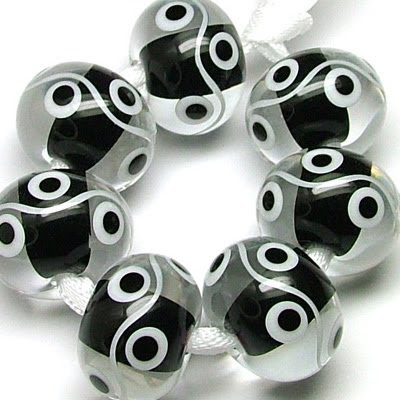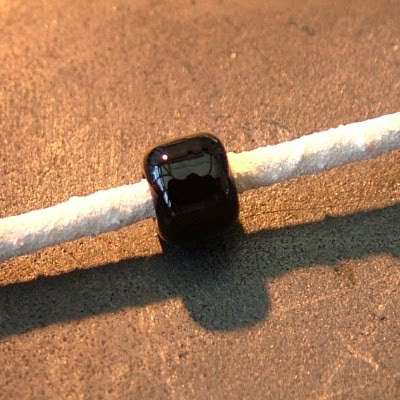 I get asked about this technique a lot. It's a very useful skill to learn and you'll find it will open up a whole new realm of potential bead designs for you. This particular type of encasing is a great way of getting a great depth to your beads. Any design applied to the surface really stands out and sometimes has that floaty kind of look to it. I've put together this ten step photo tutorial as I seem to be writing it out in words for people on a weekly basis! I hope fellow beadmakers find this helpful and even if you're not a glasshead maybe you'd like to see what goes into making an encased bead like one of those in the picture up there.
I get asked about this technique a lot. It's a very useful skill to learn and you'll find it will open up a whole new realm of potential bead designs for you. This particular type of encasing is a great way of getting a great depth to your beads. Any design applied to the surface really stands out and sometimes has that floaty kind of look to it. I've put together this ten step photo tutorial as I seem to be writing it out in words for people on a weekly basis! I hope fellow beadmakers find this helpful and even if you're not a glasshead maybe you'd like to see what goes into making an encased bead like one of those in the picture up there.
Just so you know, I have a Carlisle Mini CC torch with a torch-mounted marver and for this tutorial I'm using Efftetre black, Vetrofond clear and a 1/16 mandrel.
Step 1
 Make a tiny donut-shaped base bead. And I mean tiny. Imagine small and then make it smaller. This donut is about 5mm diameter. When you make the initial wrap touch the molten glass to the mandrel very lightly so you have a very narrow footprint.
Make a tiny donut-shaped base bead. And I mean tiny. Imagine small and then make it smaller. This donut is about 5mm diameter. When you make the initial wrap touch the molten glass to the mandrel very lightly so you have a very narrow footprint.Step 2
 Roll your tiny donut bead on a marver to create a neat cylinder. I roll mine out to about 5mm long. I say make it neat because the neater you build your bead, the less work you'll have to do in the rounding-up part of the process. And why a cylinder? Well, when you're learning to encase it's much easier to apply a casing layer to a flat surface as opposed to a round one.
Roll your tiny donut bead on a marver to create a neat cylinder. I roll mine out to about 5mm long. I say make it neat because the neater you build your bead, the less work you'll have to do in the rounding-up part of the process. And why a cylinder? Well, when you're learning to encase it's much easier to apply a casing layer to a flat surface as opposed to a round one.Step 3
 Now melt a glob of molten clear glass (not shown as I was making this bead with one hand and taking the photos with the other) that is about three times the size of the base bead. All the while you must keep your cylinder warm by flashing it in and out of the flame. When your glob of clear glass is really molten press it onto the base cylinder and wrap it around the bead. I tend to wrap and melt the glass off on the left hand side of the bead so I end up with more clear on the left hand side of the bead than the right. Don't touch the mandrel with the glass - you just want to apply it to the base bead. If you touch the mandrel with the casing glass then the bead is doomed. Unless funky, patchy encasing was the look you were going for .....
Now melt a glob of molten clear glass (not shown as I was making this bead with one hand and taking the photos with the other) that is about three times the size of the base bead. All the while you must keep your cylinder warm by flashing it in and out of the flame. When your glob of clear glass is really molten press it onto the base cylinder and wrap it around the bead. I tend to wrap and melt the glass off on the left hand side of the bead so I end up with more clear on the left hand side of the bead than the right. Don't touch the mandrel with the glass - you just want to apply it to the base bead. If you touch the mandrel with the casing glass then the bead is doomed. Unless funky, patchy encasing was the look you were going for .....Step 4
 Now add some more clear glass to even up the casing layer. As I said, I melt my clear off to the left so I always need to add more to the right. So judge it by eye and add more clear where the bead needs it. Remember - you're building the bead as evenly as you can at this point as it saves you time (and stress) later.
Now add some more clear glass to even up the casing layer. As I said, I melt my clear off to the left so I always need to add more to the right. So judge it by eye and add more clear where the bead needs it. Remember - you're building the bead as evenly as you can at this point as it saves you time (and stress) later.Step 5
 Right, now for the crucial bit. We have to melt the clear down so that we get nice neat edges to the bead without any of the base colour leaking up on to the surface. To do this, concentrate on one half of the bead at a time. Aim the flame where you want the glass to move to. Glass likes heat and it will follow it. So heat the left edge of the bead first (you could do the right side first but this is the way I do it) and you want to get the clear glass warm enough that it starts to move towards the mandrel, covering the base colour as it does so. Again, don't let the clear touch the mandrel. Stop heating just before you think you need to and then bring the bead out of the flame, keeping it turning and horizontal.
Right, now for the crucial bit. We have to melt the clear down so that we get nice neat edges to the bead without any of the base colour leaking up on to the surface. To do this, concentrate on one half of the bead at a time. Aim the flame where you want the glass to move to. Glass likes heat and it will follow it. So heat the left edge of the bead first (you could do the right side first but this is the way I do it) and you want to get the clear glass warm enough that it starts to move towards the mandrel, covering the base colour as it does so. Again, don't let the clear touch the mandrel. Stop heating just before you think you need to and then bring the bead out of the flame, keeping it turning and horizontal.Step 6

Now for the other side. Repeat the process described in step five, letting the clear glass move down towards the mandrel on the right hand side of the bead. Again, bring the bead out of the flame and let the glow come out of it.
Step 7
 At this point you may want to add a little bit more clear glass in order to make the bead up to the desired size or it may well be just the size you wanted it to be. I guess it all depends on how pernickety you are about this kind of thing ..... ;o)
At this point you may want to add a little bit more clear glass in order to make the bead up to the desired size or it may well be just the size you wanted it to be. I guess it all depends on how pernickety you are about this kind of thing ..... ;o)Step 8
 Melt the clear glass in and round up your bead. Remember to keep that mandrel horizontal.
Melt the clear glass in and round up your bead. Remember to keep that mandrel horizontal.Step 9
 This is the quality control check bit. Bring the heat out of the bead and check the bead ends to make sure you've got no colour bleed.
This is the quality control check bit. Bring the heat out of the bead and check the bead ends to make sure you've got no colour bleed.Step 10
 The finished bead. Now it's all ready to decorate!
The finished bead. Now it's all ready to decorate!Hints & Tips
When you're learning this technique it's a good idea to use a dark transparent for your base bead. This is because transparent glass doesn't bleed like opaques do and if there is any leaky colour you won't really see it.
Again, when you're practicing, my advice is to stay away from ivory as a base colour - it's tricky to case without bleeding happening.
If you're encasing black, your base bead needs to be warmer than usual (the glow must have literally just faded before you wrap it with the clear) or else it will cause scumming. Tiny little white bubbles are not all that attractive.
You don't have to stick to clear glass for the casing layer - try coloured transparents for different effects.
Etching this style of encased bead creates a gorgeous glowing effect. Take a look at my Luminobeads to see what I mean.
Try trapping some silver wire, silver foil or frit between the glass - the encasing will magnify whatever is underneath.
Don't let your bead get too hot and melty. Bring the glow out of it every now and again as this will help to stabilise it. If things get too molten it all gets out of control and starts to go wrong. Just take your time, relax and enjoy!
All images and text in this tutorial copyright © Laura Sparling 2009

Laura thank you so much for the encasing tutorial. I can't wait to try it, I am terrible at encasing.
ReplyDeleteGreat tutorial, thank you! Fantastic photos too - can't imagine the mess than would ensue if I tried to take photos whilst making a bead. Looking forward to having the chance to give it a go.
ReplyDeleteThanks so much for the tutorial - I stink at encasing too!
ReplyDeleteThis looks very helpful. Whether I'm going for thin or thick, my encasing is always resolutely medium or I get huge tennis ball sized beads! I clearly need to get my base smaller. Hint for future tutorial: thin encasing? :-)
ReplyDeleteThank you so much! I have tried it on my own in the past and was never happy with the result. This tutorial helps a lot.
ReplyDeleteHi Laura, thanks for sharing your tips i will have to give it a go.
ReplyDeleteYou're welcome everyone. I really hope it is of some use. :o)
ReplyDeletelaura.. really great tutorial..
ReplyDeleteeasy & fun...
have a great week..
mona & the girls
Oooohhhh! I can't wait to try this! I am a newbie, adn I am SO thirsty for glass knowledge! Thank you for posting this tut!!!
ReplyDeleteThanks for this clear and easy-to-understand tutorial Laura. I have been having a go at encasing this evening with (very!)limited success - going to try it your way tomorrow!
ReplyDelete